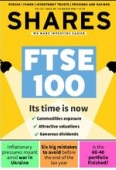Archived article
Please note that tax, investment, pension and ISA rules can change and the information and any views contained in this article may now be inaccurate.
How bond fund managers protect against rising inflation

How can your bond fund manager protect your income from rising inflation?
Most investors have some exposure to bonds through holdings in diversified funds and investment trusts. Traditionally bonds have provided good diversification and a secure income.
A bond is essentially an IOU issued by a government or business which typically pays interest at a specified rate before being repaid or ‘maturing’ on a specified date.
Investors close to, or in retirement rely on the fixed income that bonds provide, but rising energy and other living costs means that income effectively buys less.
As the name suggests a fixed income doesn’t keep pace with variable and rising living costs. You might think the answer is floating rate bonds.
These types of bonds track the prevailing level of interest rates and potentially provide a higher yield. Alas, they are not the answer, explains Phil Milburn, who manages bonds at Liontrust Asset Management.
The reason is because yields on floating rate bonds are based on short-term interest rates which are way below current inflation. UK annual inflation is running at 5.4% while short-term rates are below 0.5%.
BE DEFENSIVE AND BUY HIGHER YIELDING BONDS
Milburn told Shares there are two things bond managers can do to fight rising inflation. Firstly, adopt a more defensive approach and try not to lose money.
The easiest way to become more defensive in a rising interest rate environment is to shift into bonds which mature sooner. That’s because they are less sensitive to interest rate changes.
Maturity is the end date of the bond when an investor gets their money back.
While helpful, this approach doesn’t solve the real problem. Interest rates are at multi-year lows while inflation is at multi-year highs.
According to Milburn the best way of achieving a yield above current inflation is to hold higher yielding corporate bonds. This is debt issued by companies to fund their investments and operations.
High yield bonds have a poor reputation and are sometimes labelled junk bonds. But Milburn says this can be misleading.
He explained there are some good quality, larger companies which fall into this category and provide yields of 6.5%-to-7% at relatively low risk.
In other words, holding a proportion of high yield bonds within a well-diversified fixed income portfolio is a good way to protect against rising inflation.
To boot, high yield bonds have a shorter maturity (one to five years) which makes them more attractive when interest rates are rising.
INFLATION-LINKED BONDS NOT A PERFECT SOLUTION
Index-linked bonds are issued by the UK government and sometimes called linkers. They are designed to pay lenders extra interest to compensate the lender for increases in consumer price inflation.
In the US these are types of bond are called TIPS (Treasury inflation protected securities).
While inflation linked bonds might look like a good way to protect bond investors, they have drawbacks. They were originally created to protect pension funds’ liabilities.
These liabilities are a long way off and so they tend to have longer maturities. Milburn told Shares the average maturity of an index-linked bond is 17 years.
The problem with bonds maturing a long time in the future is their extra sensitivity to changes in interest rates. After all, the longer you have to wait until the bond matures, the greater the chance interest rates will increase beyond the level paid by the bond.
This maturity risk detracts from the overall attractiveness of linkers to hedge against inflation.
PASSIVE BOND PRODUCTS
There are clearly advantages in employing an active bond fund manager to navigate the risks of higher inflation. Getting similar protection form ETFs (exchange traded funds) is a lot harder to achieve.
That’s because going down the passive route introduces asset allocation and interest rate risk, so it is only suitable for experienced investors.
It means the investor must decide on the weightings between different types of bonds and take a view on how interest rates might change in the future.
FACTORS TO CONSIDER
It is important to understand the rules of how each fund chooses bonds to know what is included or excluded.
Investors need to ensure they purchase the appropriate currency hedged version for their needs.
The broad indices such as the Bloomberg Global Bond Aggregate Index do not provide specific inflation protection.
The index is composed of many different bonds, from government bonds, corporate bonds and mortgage backed securities across developed and emerging markets.
However, it only tracks the highest quality bonds, and therefore excludes high yield bonds we discussed earlier.
The good news is there are ETFs designed to track the corporate high yield bond markets and emerging market government bond markets.
These products are more likely to provide a yield above the current rate of inflation.
For example the $6.7 billion iShares $ High Yield Corp Bond UCITS ETF (IHHG) has a trailing yield of 5.4% and an annual ongoing charge of 0.5%.
While the $8 billion iShares J.P. Morgan $ EM Bond UCITS ETF (EMHG) has a trailing yield of 4.5% and also has an ongoing annual charge of 0.5%.
Important information:
These articles are provided by Shares magazine which is published by AJ Bell Media, a part of AJ Bell. Shares is not written by AJ Bell.
Shares is provided for your general information and use and is not a personal recommendation to invest. It is not intended to be relied upon by you in making or not making any investment decisions. The investments referred to in these articles will not be suitable for all investors. If in doubt please seek appropriate independent financial advice.
Investors acting on the information in these articles do so at their own risk and AJ Bell Media and its staff do not accept liability for losses suffered by investors as a result of their investment decisions.

 magazine
magazine








